MusicRadar Verdict
On a production and sonic level, ARO Symphonic Strings Pro represents the very best of orchestral sampling, but you will have to negotiate Spitfire's player format into the bargain!
Pros
- +
All String section instrumentation is represented individually.
- +
Large variety of articulation, especially in legato form.
- +
The sonic reproduction is sublime.
- +
Huge stock of mic signals, if required!
Cons
- -
No Con Sord articulation.
- -
No ensemble patching.
- -
Very slow sample loading.
MusicRadar's got your back
Spitfire Audio Abbey Road Orchestra Symphonic Strings Professional: What is it?
If you have ever been in north-west London, you may have stumbled across the infamous studio complex in Abbey Road. Even if you didn’t see the studios, you would definitely notice the infamous zebra crossing, thanks to the numerous pedestrians trying to recreate the classic Beatles pose!
Placing its association with a popular beat-combo from the sixties to one side, Abbey Road Studios continue to be much in-demand. It provides numerous studios designed to accommodate all sizes of ensemble and session, from mastering rooms, up to full-scale symphonic recording. The largest live room within the complex is Studio One, which plays host to Spitfire’s latest string library.
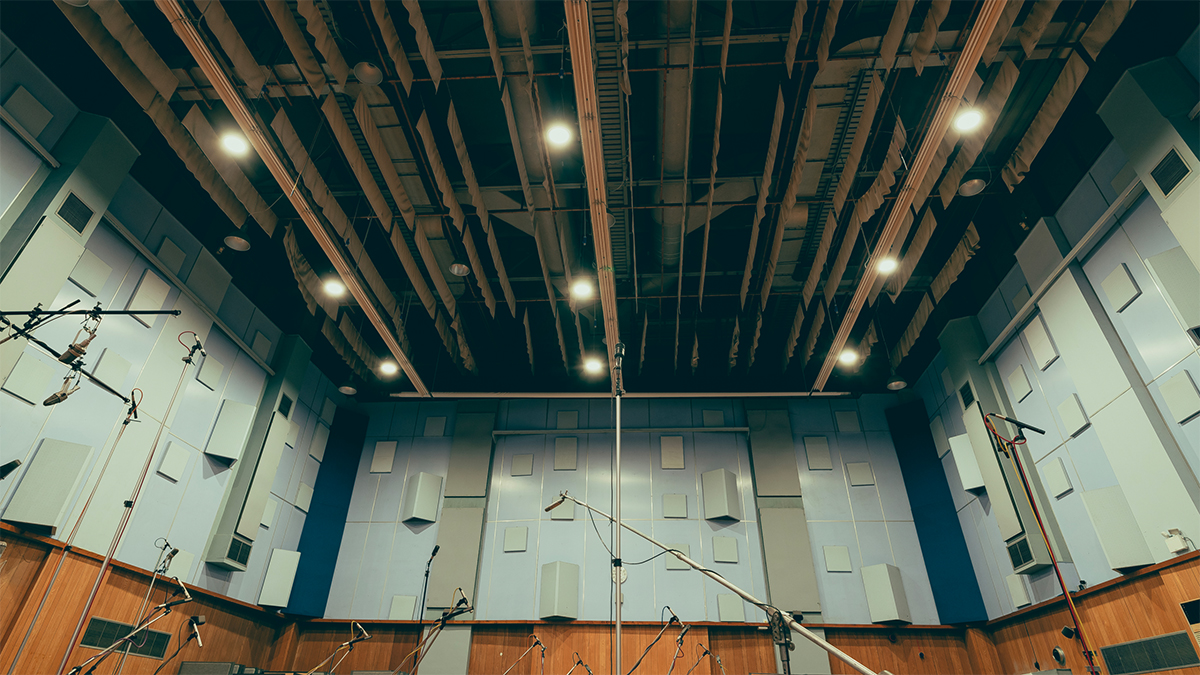
Abbey Road Orchestra Symphonic Strings Professional (which we’ll now refer to as ARO Strings) was recorded in the room that has played host to some of the most iconic film scores in history, from Star Wars to James Bond. Many notable rock and pop acts have also recorded here, or added larger ensembles to their existing works-in-progress.
ARO Strings does feel like it has been in the works for quite a while, as there have been previous releases with differing designation of strings, other instrumentation, or even other rooms. The professional package brings greater flexibility to the table, with individual instrumental sections, which would notably be required by anyone scoring in a traditional or professional setting.
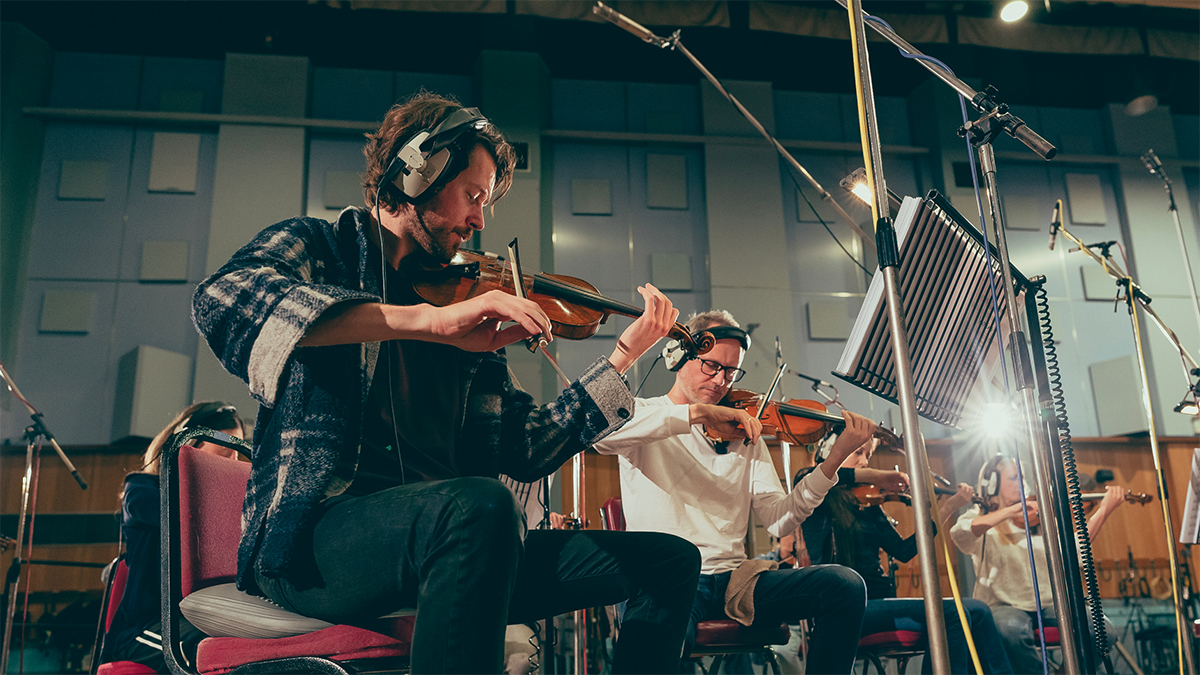
Spitfire Audio Abbey Road Orchestra Symphonic Strings Professional: Performance and verdict
ARO Strings is a bundle package, containing the five elements from an orchestral string section; sixteen 1st Violins, fourteen 2nd Violins, twelve Viola, ten Cellos and eight Double Basses. You do have the option to buy each section individually, but there is a substantial saving, if purchased together as this bundle.
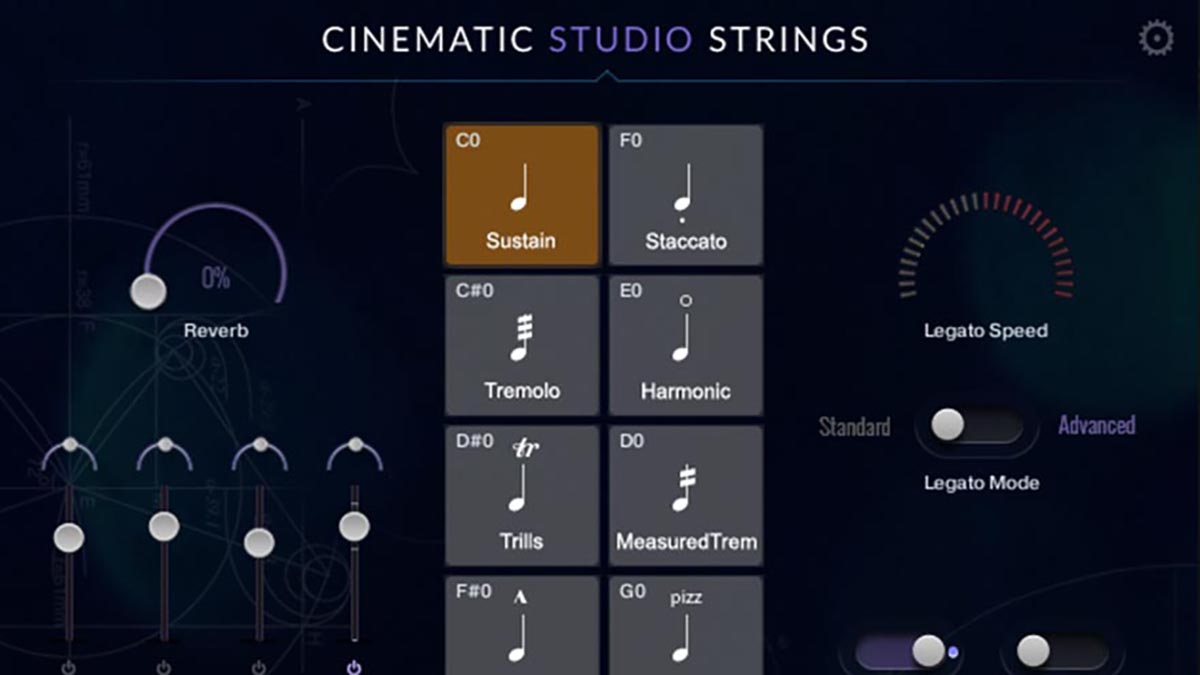
• Cinematic Studio Series Strings
Recorded in the environment of a dry sound stage, CS Strings is another versatile symphonic package, with a very responsive Kontakt-based user interface.
• Orchestral Tools Peteris Vasks Strings
Based around a smaller chamber-sized string section, Vasks Strings is deeply sampled, with some of the finest legato patching we have heard.
Being the professional iteration of this package, it represents the fullest collection of articulation options and microphone signals. All of the instrumentation has been recorded in place, so elements such as panning have already been handled, the concept being that you can just play, and everything will sit in place, in your mix.
This is unsurprisingly a large collection of samples, although it could be considered somewhat smaller than some of Spitfire’s other string offerings. You will need 407.85GB of disk space and quite a bit of patience while you wait for the proceeding download.
Want all the hottest music and gear news, reviews, deals, features and more, direct to your inbox? Sign up here.
ARO Strings occupies the same player territory as previously released Abbey Road products. If you already own Abbey Road Percussion, you will see this residing alongside the strings, in Spitfire’s own plugin format. Thinking toward the longer term, this could become your A-list orchestra, with everything contained within, much like Spitfire’s BBC Symphony Orchestra plugin.

We hope we passed the audition
We start auditioning from the top of the section, with the 1st Violins. There are 26 different articulation styles available for the section, all of which are key-switchable via MIDI. We notice a very heavy concentration on different styles of legato playing; this is the Italian term and direction to play phrases smoothly.
The default performance legato is exceptionally impressive, but to re-create something believable, it is essential to employ the performance controls, which we had set on standard MIDI CC faders. With dynamic layering, vibrato and expression all under control, it was relatively easy to create impressive sweeping lines, with the additional ability to implement a portamento glide, by playing the keyboard in its lowest velocity zone.
There is a very notable amount of latency and lag when playing live, which is an indication of the quality of the programmed legato samples. Latency is a necessary evil for just about all legato patches, in order to get the best movement from one note to the next. This can make it difficult to play in time, particularly when tracking, so many users find themselves initiating an additional sound, such as a piano, to make playing a little easier. We also found it necessary to nudge the timing of tracks in the DAW, to get the legato to sit in place. Once again, this is a pretty standard procedure for any orchestral scoring.
The string articulations that provide a harsh attack, such as staccato and marcato, are very quick to respond. There is no lag here, and the resultant sound is equally impressive. Spitfire has initiated a number of velocity zones, so the samples will react as you play more aggressively, with certain instances of upper velocities becoming very agitated with effects such as slapping.
Among the other articulation entries, there are tremolos and long notes, and we have to give special mention to the Legato Runs articulation, which handles swifter movement very ably.
While there is much to applaud, there is a very notable omission, with no Con Sord (muted) sample. This has been a particular Spitfire highlight in the past, so it's a little disappointing that this should not be present in a professional grade library.
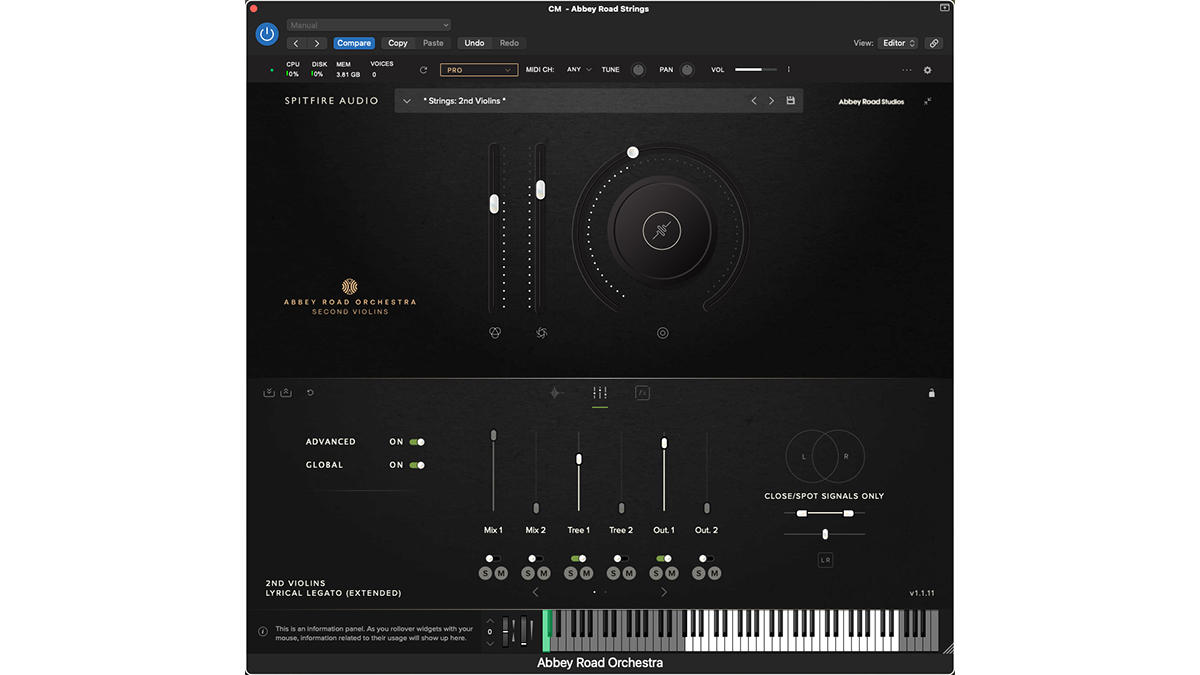
I’m down
The articulation content varies from one instrumental section to the next, but it is fair to say that just about everything you are likely to need will be available, with the exception of the Con Sord articulation.
Another omission, which feels like a missed opportunity, is any form of ensemble patch. Within a professional package, having the freedom to score traditionally is really important, but sometimes you just want to sketch out an idea quickly, working across the entire range of the string section.
There is no capacity to do this, unless you wish to go to the trouble of creating a bespoke template within your DAW. With a lack of multitimbral option within the plugin itself, this might not be easy to organise.
We did also feel that the Viola section didn't perform as well, particularly in the legato realm. It seemed more difficult to get a realistic result, if compared to the 1st Violin section, with phrasing often sounding lumpy, with the progression of each note.
The Cello section, on the other hand, straddles both the melodic and bass registers quite happily. When coupled with the impressive Bass section, the sonority and emotion that can be created is impressive.
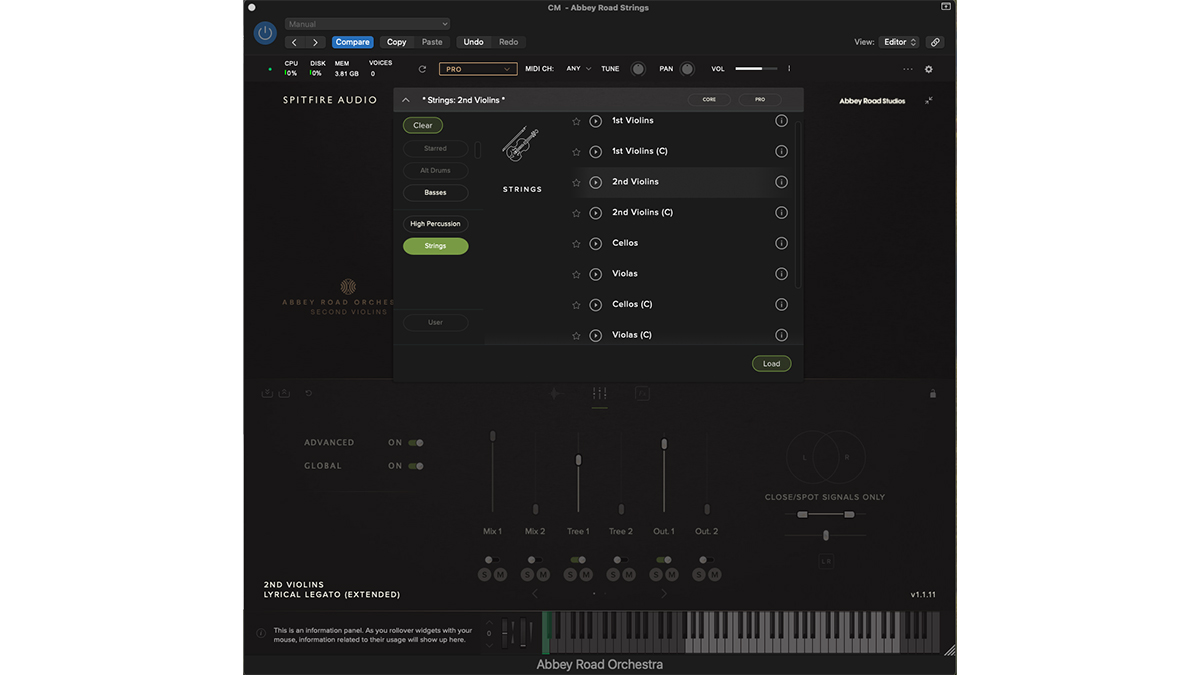
Core elements
There is no doubt that ARO Symphonic Strings Professional provides a bewildering number of articulation options, but it is entirely likely that some of those options may simply not be required. The professional package offers a vast number of microphone channels and signals, the concept being that you can zone in to cater to the sound that you require. The only problem with this, is that every time you open up an additional mic channel, you add even more to the sample loading that you have in play.
Spitfire has always been relatively aware of this point, creating exceptionally useful mixed and blended signals, curated by Grammy award-winning engineer, Simon Rhodes. As a possible response, there is an opportunity to adopt this package with just a single supplied mix, and at a vastly reduced price tag. ARO Symphonic Strings Core is exactly that; all of the same content, but with a single microphone mix, and even better, the bundle price is only £599 for the entire string section. These Core elements are also available individually, so you could theoretically save even more, if you only needed the 1st Violin section, although we have to conclude that the quality of the samples is such, you are only ever going to want to use the whole thing!

Let us take you down…
It is very difficult to completely nail every element and nuance of a string section, and on a sonic level, much of this library is incredibly classy. These sounds can be manipulated further, through the unbelievably extensive array of included microphones and mixes. You do however have to be careful, as opening up each mic channel results in more samples being loaded, and we quickly found ourselves with over ten gigabytes of samples lock and loaded, which for a single instrument is not an option for many current computers.
However, we must address the marmite-like elephant in the room; Spitfire’s own player. Firstly, it is not multitimbral, which can make usage more long-winded in certain working scenarios. Secondly, and possibly most important of all, loading times remain quite slow, at least if compared to other player formats, such as Kontakt. We were testing ARO Strings on an up-to-date Mac with samples hosted on SSD, with tested retrieval speeds of 450Mbs. Projects containing only five player instances would take several minutes to load, which could become a real bug-bear if working on multiple projects or cues.
Spitfire’s player aside, this is a hugely versatile and impressive package at the sonic level, and one that that covers most bases incredibly well. But the player may put professionals off, who need to quickly shift from cue to cue.
MusicRadar verdict: On a production and sonic level, ARO Symphonic Strings Pro represents the very best of orchestral sampling, but you will have to negotiate Spitfire's player format into the bargain!
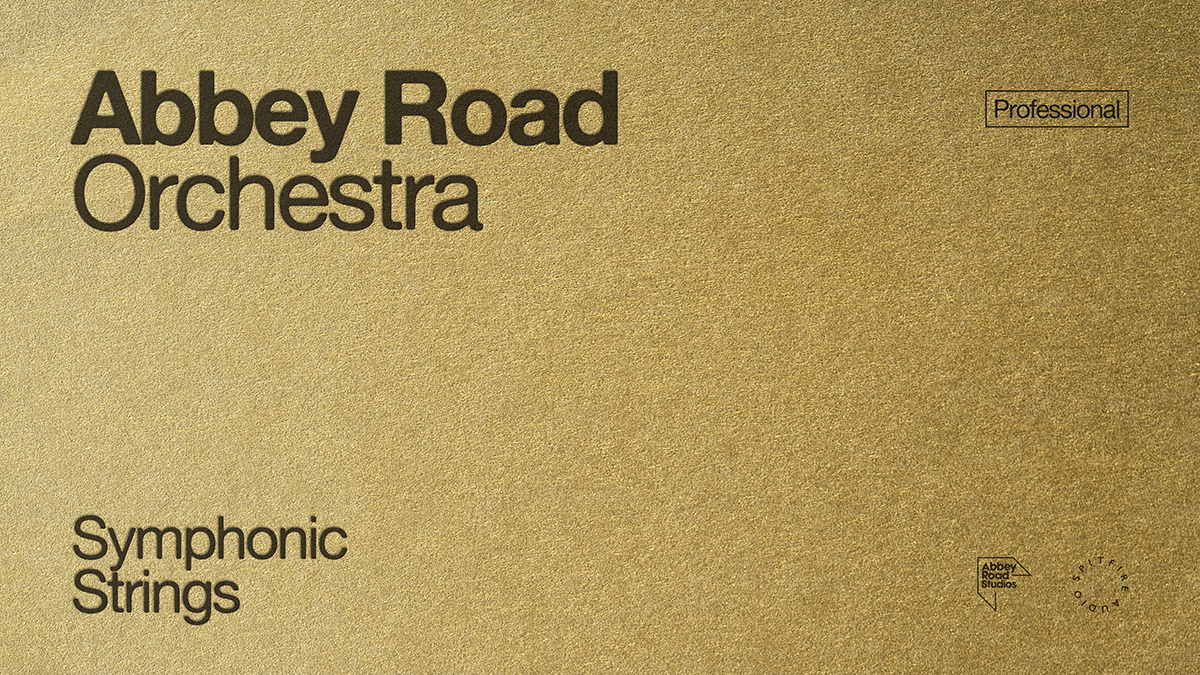
Spitfire Audio Abbey Road Orchestra Symphonic Strings Professional: Hands-on demos
Spitfire Audio
SecondTierSound
Guy Michelmore
The Sampleist

Spitfire Audio Abbey Road Orchestra Symphonic Strings Professional: Specifications
- macOS OS X 10.15 to OS 14. Both Intel and Apple Silicon/ARM are supported.
- Windows 10 or Windows 11. (Latest Service Pack, 64-bit).
- Plugin formats: AU, VST2/3 & AAX.
- CONTACT: Spitfire Audio
Roland Schmidt is a professional programmer, sound designer and producer, who has worked in collaboration with a number of successful production teams over the last 25 years. He can also be found delivering regular and key-note lectures on the use of hardware/software synthesisers and production, at various higher educational institutions throughout the UK
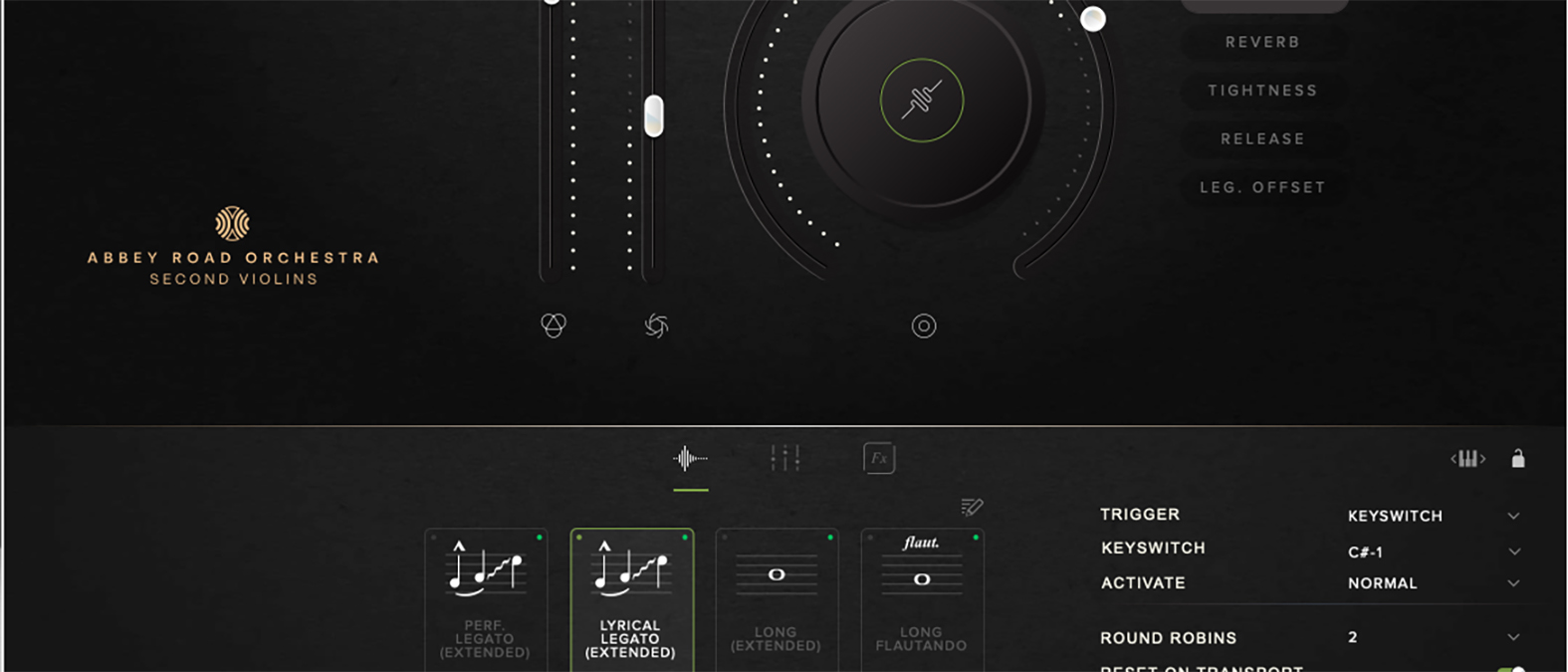


![Spitfire's Abbey Road Strings - [SCORING and REVIEW] - YouTube](https://img.youtube.com/vi/GGJ98h04GYI/maxresdefault.jpg)
